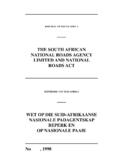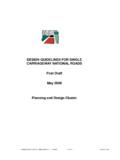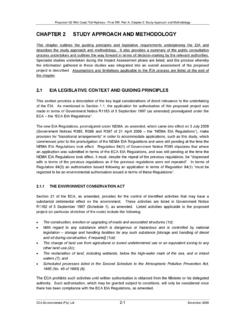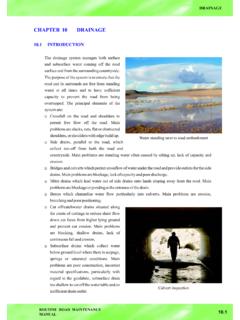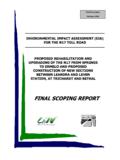Transcription of TRH 11 DIMENSIONAL AND MASS LIMITATIONS AND OTHER ...
1 TRH 11 DIMENSIONAL AND MASS LIMITATIONS AND OTHER REQUIREMENTS FOR ABNORMAL LOAD VEHICLES 8th Edition August 2009 i ISBN 978-0-620-42786-9 Published in August 2009 by the Department of Transport Private Bag X193 PRETORIA 0001 REPUBLIC OF SOUTH AFRICA Earlier Editions: First Published in 1974 First revision in May 1979 Second revision March 1981 Reprinted in June 1982 Third revision April 1987 Fourth revision April 1992 Fifth revision November 1992 Sixth revision September 1997 Seventh revision March 2000 Printed in the Republic of South Africa ii FOREWORD The history of TRH 11 dates back to 1970, when a committee, the Committee on Abnormal Loads, was formed comprising a team of traffic, road and structural engineers. This committee was tasked to develop recommendations for the adoption of a uniform approach to administer and govern the registration of abnormal vehicles and the conveyance of abnormal loads in South Africa.
2 Throughout its history, the document they developed, generally known as TRH 11, remained under the care and development of this committee, now known as the Abnormal Loads Technical Committee. The document has been updated on a number of occasions on a needs basis to accommodate developments and trends in the transportation industry and a stage was reached where there was general consensus that the document needed a major revision. This latest version is the result of this major revision. The objectives that were set for this latest revision of TRH 11 included the review of various requirements and technical provisions and the simplification and clarification of the document through the elimination of contradictions, ambiguities and duplications. In this latest revision, the technical issues and the administrative issues have been rightfully separated. The TRH 11 now focuses on technical issues, while a separate document, the Administrative Guidelines for Granting of Exemption Permits for the Conveyance of Abnormal Loads, has been developed.
3 This latter document outlines the detailed procedures to follow when applying to register and operate abnormal vehicles and includes the rules or conditions which apply to the transporting of abnormal loads. This latest revision process included comprehensive interaction with industry stakeholders (consignees, consignors, hauliers, manufacturers, industry associations and interested stakeholders/parties); as well as road and traffic authorities and I want to thank all those individuals and organizations for their participation and for the valuable input given. Now that these guidelines have been revised, I appeal to all officials involved with the registering of abnormal vehicles and the issuing of exemption permits to apply these guidelines in a uniform way and to consult and interact with their counterparts in OTHER provinces in order to achieve this It was a great privilege to have worked with the team that developed this current version of TRH11 - DIMENSIONAL and Mass LIMITATIONS and OTHER Requirements for Abnormal Loads and the Administrative Guidelines for Granting of Exemption Permits for the Conveyance of Abnormal Loads.
4 Prasanth Mohan Chairman: Abnormal Load Technical Committee Deputy Manager: Overload Control Department of Transport iii SYNOPSIS The National Road Traffic Act (Act 93 of 1996) and the National Road Traffic Regulations, 2000 prescribe certain LIMITATIONS on vehicle dimensions and axle and vehicle masses that a vehicle using a public road must comply with. However, certain vehicles and loads cannot be moved on public roads without exceeding the LIMITATIONS in terms of the dimensions and/or mass as prescribed. Where such a vehicle or load cannot be dismantled, without disproportionate effort, expense or risk of damage, into units that can travel or be transported legally, it is classified as an abnormal load and is allowed to travel on public roads under an exemption permit issued in terms of Section 81 of the National Road Traffic Act. In this document various types of abnormalities and abnormal load and vehicle configurations are described.
5 Abnormal load classification in terms of dimensions and mass is presented and routes are categorised in terms of paved width and posted speed limit. DIMENSIONAL and mass LIMITATIONS for abnormal vehicles allowable under an exemption permit are defined. Marking and escorting requirements and speed restrictions applicable to abnormal vehicles are described. An overview of methods to estimate road pavement damage by abnormal vehicles is given. iv TABLE OF CONTENTS 1. Introduction .. 1-1 Background .. 1-1 Types of Abnormalities .. 1-2 Dimension Abnormality .. 1-2 Mass Abnormality .. 1-2 Load and Vehicle Configurations .. 1-2 Multiple Indivisible items in One Abnormal Load .. 1-4 Abnormal Load Classification .. 1-5 Background .. 1-5 DIMENSIONAL Classification .. 1-5 Mass Classification .. 1-5 Categories of Routes .. 1-5 Background .. 1-5 Route Classification.
6 1-6 2. DIMENSIONAL LIMITATIONS .. 2-1 Background .. 2-1 Length .. 2-1 Legally Permissible .. 2-1 Allowable under Permit .. 2-2 Width .. 2-2 Legally Permissible .. 2-2 Allowable under Permit .. 2-2 Height .. 2-3 Legally Permissible .. 2-3 Allowable under Permit .. 2-3 Overhangs .. 2-3 Front Overhang .. 2-4 Rear Overhang .. 2-4 Load Projections .. 2-5 Front Load Projection .. 2-5 Rear Load Projection .. 2-5 Wheelbase .. 2-6 Legally Permissible .. 2-6 Allowable under Permit .. 2-6 Turning Radius .. 2-6 Legally Permissible .. 2-6 Allowable under Permit .. 2-6 v Stability .. 2-7 Ground Clearance .. 2-7 3. Mass LIMITATIONS .. 3-1 Background .. 3-1 Loads on Tyres .. 3-1 Legally Permissible .. 3-1 Allowable under Permit .. 3-1 Manufacturer s Ratings .. 3-1 Legally Permissible .. 3-2 Allowable under Permit .. 3-2 Massload Carrying Capacity of 3-2 Legally Permissible.
7 3-2 Allowable under Permit .. 3-2 Massload Carrying Capacity of Bridges and Culverts .. 3-3 Legally Permissible .. 3-3 Allowable under Permit .. 3-3 Distances between Axle Groups .. 3-4 Tracking Requirements .. 3-4 LIMITATIONS Imposed by Drawing Vehicles (Power to Mass Ratio) .. 3-6 Legally Permissible .. 3-6 Allowable under Permit .. 3-6 Massload on Drive Axles (Traction Ratio) .. 3-6 Legally Permissible .. 3-7 Allowable under Permit .. 3-7 Massload on Steering Axles (Steering Ratio) .. 3-7 Legally Permissible .. 3-7 Allowable under Permit .. 3-7 4. Marking and 4-1 Introduction .. 4-1 Description of Warning Apparatus .. 4-1 Flags .. 4-1 Boards .. 4-1 Lights .. 4-2 Warning Apparatus Requirements .. 4-3 Long and Wide Loads .. 4-3 Projections .. 4-3 Night 4-3 Speed Restrictions .. 4-3 Warning Apparatus Prohibited .. 4-3 vi Escorting of Abnormal Vehicles.
8 4-4 Background .. 4-4 Escort Classes .. 4-4 Escort Requirements .. 4-4 5. Speed Restrictions .. 5-1 Background .. 5-1 Tyre Loading .. 5-1 Bridge Loading .. 5-1 Dimensions .. 5-2 Mobile Cranes .. 5-2 6. Estimation of Relative Road Pavement Damage by Abnormal Vehicles .. 6-1 Introduction .. 6-1 Equivalent Single Wheel Mass (ESWM) Method .. 6-1 South African Mechanistic-empirical Pavement Design Methodology (SAMDM) .. 6-1 7. Technical Detail and Calculations .. 7-1 Introduction .. 7-1 Detailed Glossary .. 7-1 5th Wheel .. 7-1 Axle Configurations .. 7-1 Legal Axle Loads .. 7-2 Road Usage Factor (RUF) Calculation .. 7-2 Effective Width Calculation .. 7-2 Effective Width of a Single Axle or Single Axle Group .. 7-2 Weighted Effective Width Calculation .. 7-3 Tyre Pressure Calculation .. 7-4 8. References .. 8-1 APPENDICES Appendix A: Regulations applicable to Abnormal Loads and Vehicles.
9 1 vii LIST OF TABLES Table : Classification According to Dimensions .. 1-5 Table : Classification According to Mass .. 1-5 Table : Route Classification .. 1-6 Table : Maximum Overall Legal Dimensions (GVM/GCM exceeds 12 t) .. 2-1 Table : Maximum Overall Legal Length (including load projections) .. 2-1 Table Maximum Overall Length per Vehicle Type (including load projections) .. 2-2 Table : Actions Required when Transporting High Loads .. 2-3 Table : Allowable Front/Rear Overhang under Permit.. 2-4 Table : Allowable Rear Load Projections .. 2-5 Table : Triggering Values for Stability Checks .. 2-7 Table : LIMITATIONS on the Maximum Allowable Load (in kg) on Multi Axle Groups imposed by Bridges and Culverts .. 3-5 Table : Warning Apparatus Requirements for Long and Wide Loads .. 4-3 Table : Escort Requirements for Wide and Long Loads in terms of Dimension Class and Route Category.
10 4-4 Table : Escort Requirements for Wide and Long Loads in terms of the 4-5 Table : Speed Restrictions due to Tyre Loading .. 5-1 Table : Maximum Allowable Speeds over Bridges .. 5-1 Table : Maximum Allowable Speeds for Vehicles or Loads of Abnormal Dimensions .. 5-2 Table : Maximum Allowable Speeds for Mobile Cranes .. 5-2 Table 7-1: Examples of RUF Calculations .. 7-2 Table : Variation in Load Capacity with Speed* .. 7-5 Table : Example of a Load at Pressure Table .. 7-6 LIST OF FIGURES Figure : Abnormal Load on a Legal Combination .. 1-3 Figure : Abnormal Load on a Long Wheelbase Trailer .. 1-3 Figure : Self-Supporting Load on a Steerable Dolly .. 1-3 Figure : Heavy Loads on Multi-axle or Modular Trailers .. 1-3 Figure : Abnormally Heavy Mobile 1-3 Figure : Multiple Indivisible Items in One Abnormal Load.. 1-4 Figure : Front and Rear Overhangs .. 2-3 Figure : Load Projections.

